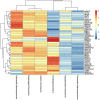Chromatin Dynamics in Digestive System Cancer: Commander and Regulator
- PMID: 35965507
- PMCID: PMC9372441
- DOI: 10.3389/fonc.2022.935877
Chromatin Dynamics in Digestive System Cancer: Commander and Regulator
Abstract
Digestive system tumors have a poor prognosis due to complex anatomy, insidious onset, challenges in early diagnosis, and chemoresistance. Epidemiological statistics has verified that digestive system tumors rank first in tumor-related death. Although a great number of studies are devoted to the molecular biological mechanism, early diagnostic markers, and application of new targeted drugs in digestive system tumors, the therapeutic effect is still not satisfactory. Epigenomic alterations including histone modification and chromatin remodeling are present in human cancers and are now known to cooperate with genetic changes to drive the cancer phenotype. Chromatin is the carrier of genetic information and consists of DNA, histones, non-histone proteins, and a small amount of RNA. Chromatin and nucleosomes control the stability of the eukaryotic genome and regulate DNA processes such as transcription, replication, and repair. The dynamic structure of chromatin plays a key role in this regulatory function. Structural fluctuations expose internal DNA and thus provide access to the nuclear machinery. The dynamic changes are affected by various complexes and epigenetic modifications. Variation of chromatin dynamics produces early and superior regulation of the expression of related genes and downstream pathways, thereby controlling tumor development. Intervention at the chromatin level can change the process of cancer earlier and is a feasible option for future tumor diagnosis and treatment. In this review, we introduced chromatin dynamics including chromatin remodeling, histone modifications, and chromatin accessibility, and current research on chromatin regulation in digestive system tumors was also summarized.
Keywords: chromatin dynamics; clinical trials; digestive system tumor; epigenetics; targeted therapy.
Copyright © 2022 Li, Zhao, Qin, Wang, Li and Wang.
Conflict of interest statement
The authors declare that the research was conducted in the absence of any commercial or financial relationships that could be construed as a potential conflict of interest.
Figures



Similar articles
-
Biophysics of Chromatin Dynamics.Annu Rev Biophys. 2019 May 6;48:321-345. doi: 10.1146/annurev-biophys-070317-032847. Epub 2019 Mar 18. Annu Rev Biophys. 2019. PMID: 30883217 Review.
-
Environmental-stress-induced Chromatin Regulation and its Heritability.J Carcinog Mutagen. 2014 Jan 15;5(1):22058. doi: 10.4172/2157-2518.1000156. J Carcinog Mutagen. 2014. PMID: 25045581 Free PMC article.
-
Altered primary chromatin structures and their implications in cancer development.Cell Oncol (Dordr). 2016 Jun;39(3):195-210. doi: 10.1007/s13402-016-0276-6. Epub 2016 Mar 23. Cell Oncol (Dordr). 2016. PMID: 27007278 Review.
-
Deregulated chromatin remodeling in the pathobiology of brain tumors.Neuromolecular Med. 2013 Mar;15(1):1-24. doi: 10.1007/s12017-012-8205-y. Neuromolecular Med. 2013. PMID: 23114751 Review.
-
Changing the DNA landscape: putting a SPN on chromatin.Curr Top Microbiol Immunol. 2003;274:171-201. doi: 10.1007/978-3-642-55747-7_7. Curr Top Microbiol Immunol. 2003. PMID: 12596908 Review.
Cited by
-
Chromatin Remodeling-Related PRDM1 Increases Stomach Cancer Proliferation and Is Counteracted by Bromodomain Inhibitor.J Pers Med. 2024 Feb 20;14(3):224. doi: 10.3390/jpm14030224. J Pers Med. 2024. PMID: 38540967 Free PMC article.
-
DNA choreography: correlating mobility and organization of DNA across different resolutions from loops to chromosomes.Histochem Cell Biol. 2024 Jul;162(1-2):109-131. doi: 10.1007/s00418-024-02285-x. Epub 2024 May 17. Histochem Cell Biol. 2024. PMID: 38758428 Free PMC article.
-
Tumor dormancy and relapse: understanding the molecular mechanisms of cancer recurrence.Mil Med Res. 2025 Feb 11;12(1):7. doi: 10.1186/s40779-025-00595-2. Mil Med Res. 2025. PMID: 39934876 Free PMC article. Review.
References
Publication types
LinkOut - more resources
Full Text Sources

